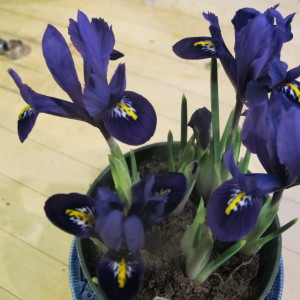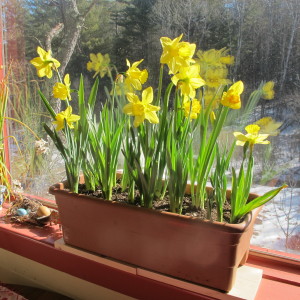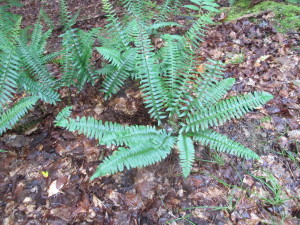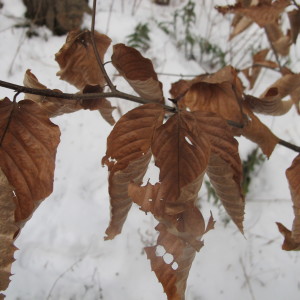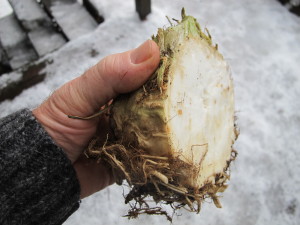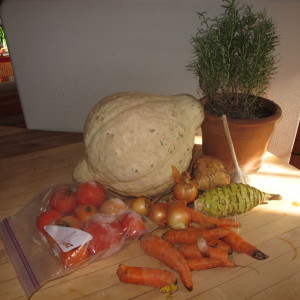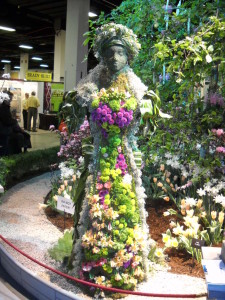Potted Bulb Plants
As we amble toward spring I find I crave blossoms more and more. This must delight the people who sell flowers, as I have a hard time walking by a display of iris or daffodils growing in pots without buying some. But buying grocery store potted bulb-flowers is not just an indulgence. Many can be kept alive until the ground thaws and planted. Others are less durable. Let’s take a look.
I love those little purple iris that are commonly sold in 4-inch pots. I bought some recently for $3.99 and although they only lasted a week, I was delighted to have them. This particular iris is known to botanists by its Latin name, Iris reticulata. It’s related to Siberian iris and bearded iris, but has different growing needs.
According to the tag that came with the iris, you can plant these outdoors “in part shade after last spring frost.” What they don’t tell you is that Iris reticulata require very good drainage. They originated in the mountains of western Asia where they grow wild on pumice slopes of extinct volcanoes.
If you want these fabulous little iris to succeed for you, do not plant them in a heavy clay soil. In fact, build a six-inch raised bed of sandy soil and grit with very little organic matter. Outline your planting bed with stones or bricks. You should be able to pour water from your watering can over the bed and not have any pooling. Planting on a hillside will help with drainage, too. Most of my soil is too rich for Iris reticulata, so I’ve not had good luck with them after the first year. I guess this year I’ll build them their own little bed.
Tete-a-tete daffodils are great little bundles of yellow joy that are common in grocery stores and at flower shows. Each bulb produces more than one mini daffodil. They are very cold hardy and can be planted outdoors when the soil has thawed. Just keep them watered indoors after blooming. Like other small bulbs, plant the tips just 2 inches beneath the soil surface.
Every year I force paper whites. Also in the daffodil family, these are not usually planted in soil indoors, but in a container filled with pebbles. Choose one that has no holes and arrange the paper whites bulbs among the stones. Later, when the leaves and stems are tall, they will tip over unless you arrange your stones so that they hold the bulbs in place. I add water until it just kisses the bottom of the bulbs. Roots emerge and soon thereafter green leaves and flower buds emerge. Each bulb should produce more than one blossom.
The paper white flowers are usually – though not always – highly fragrant. Some people do not like the scent, though I do. And even after the flowers have dried out they still look good to me for quite a while. The unfortunate part about paperwhites is that they are not viable in our climate outdoors. No, do not save them and plant outdoors. They will not come back for you next year.
I also potted bulbs for forcing that I put in my cold basement last November, and I have brought them up into the light and warmth of the house. This year I used a plastic container called an “Earth Box” for planting. The one I used is 22 inches long, 9 inches wide and has a planting space about 7 inches deep; I planted about 20 bulbs in it. It is a “self-watering container” that has a water holding compartment a couple of inches deep.
Self-watering containers are all the rage for growing flowers on decks and doorsteps. They prevent the dehydration (and death) that old fashioned flower pots allowed. They wick up water from the water reservoir so that you only have to water once a week or so, depending on the weather. But they are great as containers for bulbs, too, because they don’t leak water out onto your table or windowsill unless you dump gallons of water and make them overflow.
Tulips are some of my favorite flowers but are also loved by deer, chipmunks, voles (but never moles), red squirrels, gray squirrels and a variety of other rodents. The bulbs are even edible by humans – some Dutch ate them to avoid starvation in WWII. So most years I plant some in pots and force them to bloom indoors. Just enjoy them now.
My personal experience is that tulips bloom well their first year –indoors or out – but fewer and fewer bloom each year thereafter. So if you buy potted tulips at the florist shop or nursery, I don’t think they are worth babying along until summer and planting outdoors in May.
I planted 100 tulips in a big raised bed in my vegetable garden last fall. I planted a few garlic cloves in with them in an effort to discourage rodents, though that is no sure cure. In the past deer have not bothered my tulips, but if I am feeling paranoid or see lots of footprints near the tulip bed, I could surround it with a chicken wire fence. Since the bed is only 8 feet by 3 feet, even a 4-foot fence should keep out the deer, I believe. I will use the tulips as cut flowers.
So brighten your house with some flowers grown from bulbs. Most you’ll be able to plant outdoors for another show next year, albeit later.
Henry may be reached by e-mail at henry.homeyer@comcast.net or at P.O. Box 364, Cornish Flat, NH 03746. Please include a stamped envelope if you wish a response by mail.
Thoughts of Charles Darwin During a Walk in the Woods
I have great respect for Charles Darwin. He was a scientist who traveled around the world, observed nature, kept great records, collected specimens, applied logic and came up with a theory that changed how we see the world. He wrote The Origin of Species in 1859 which presented, clearly and forcefully, the theory which became known as evolution.
Darwin postulated that from time to time plants and animals had mutations that made them more or less competitive than others of their species. Those that were better able to survive had more progeny and their changes were more likely to persist and dominate. “Survival of the fittest” became a mantra of scientists that we’ve all heard.
On a recent walk in the woods I pondered Darwin’s ideas as I looked at the flora of the forest. At the forest floor I observed just one species of fern, the Christmas fern (Polystichum acrostichoides). It was everywhere I looked. Its greenery on that warm, sunny day presumably was using February sunshine to produce food for its roots. I know there are many other ferns in the woods, but all the others had lost their leaves in the fall, and were dormant. Using sunshine in winter must be an evolutionary advantage.
Next I reflected on the wildflowers I love. Early spring bloomers like hepatica are short and bloom before forest trees have leaves. Fall bloomers like goldenrod and cardinal flower are taller. Why is that? They may have evolved in competition with grasses and other tall plants that would shade out shorter things. Plants seem to time their blooming so that they will survive and thrive.
I have often wondered why young beech trees and some oaks hold onto their leaves until spring. Researching this on the web, I found a fabulous article in Northern Woodlands Magazine (http://northernwoodlands.org) by Vermont forester Michael Snyder. He explained that the first prehistoric trees were all evergreen, and that deciduous trees developed later. In cold regions such as ours, shedding leaves helps to minimize water loss and damage due to the cold.
The process of holding onto brown leaves until spring is called marcescence. Snyder postulated several reasons why this ability to hold onto leaves might be an advantage. First he noted that dropping leaves in spring might provide some organic matter as mulch just when a growing plant needs it. Leaves left on the ground all winter would be farther along in the decomposition process. In my view, that doesn’t make sense – trees that are growing green leaves need nitrogen, and brown leaves have little to offer. Nitrogen usually off-gasses when leaves turn brown, going back to the atmosphere. Sure, organic matter in the form of carbon does enrich the soil, but that is a slow process.
Snyder wrote that some other researchers suggest the leaves might help to trap snow in winter, thus retaining water. That does not match with my observations. Others suggested that the leaves might provide some protection to leaf buds against the cold. Again, that is not logical to me. Lastly, he proposes that the leaves might be a deterrent to hungry deer browsing tips of branches, removing leaf buds in winter. Yes, that makes a certain amount of sense to me.
Most trees are adapted to thrive either in sun or shade, but not both. The Canadian hemlock, one of the most common trees in my environment, can grow pretty much anywhere – full sun to full shade (though it does not do well in soggy soil). I can see why it so common in the wild. But it does not do well with road salt or pollution. Will this tree develop new varieties that are tolerant of human interference? Remember that evolution is very slow, often taking millions of years to create new species.
In marketing circles the promoters of a new product are always looking for a “market niche.” This means finding a product that no one else is selling, whether that be a wrist-watch computer or a new type of hair gel. It seems that plants do much the same. They “look for” a place where other plants don’t want to be or can’t succeed.
A great example of a plant market niche is on bare rocks. With no soil what self-respecting plant would want to grow there? Enter the lichens. These are relatively primitive living things that can survive on bare rock in full sun. Technically, they are not even plants.
Lichens are two life forms living together in a symbiotic relationship: fungus and algae or cyanobacteria. Those latter beings can, by photosynthesis, produce food; the fungus provides structure and moisture it gathers. Each species helps the other, and is helped by it. What an amazing evolutionary miracle! Together these living creatures have evolved the ability to live from Antarctica to tropical jungles. Lichens cover roughly 6% of our land mass – so I guess they’ve had good luck finding market niches.
So go for a walk and ponder the miracles of life. And try to figure out why beeches and oaks hold onto their leaves. If you come up with a new theory, be sure to let me know. I’m still not convinced I know the answer.
Henry is a UNH Lifetime Master Gardener and the author of 4 gardening books. His website is www.Gardening-Guy.com.
Groundhog (Day) Soup
The old timers say that on Ground Hog Day we should still have half our wood supply – or more. This year I had more than half as it’s been a warm winter. Or perhaps not a real winter at all. At the half way point I always want to still have plenty of vegetables left from the summer, and I do. To celebrate Ground Hog Day this year I made a soup of my own vegetables, largely with root crops stored in the basement in an old fridge. Here is what I used:
Ground Hog Soup
1 rutabaga, cut in ½ inch cubes
1 kohlrabi, cut in ½ inch cubes
5 carrots, cut in rounds
3 medium-small yellow onions, finely chopped
½ a small celeriac, finely chopped
1 huge garlic clove, finely chopped
5 frozen whole large tomatoes (or substitute a 28 oz can crushed tomatoes)
2 cups winter squash, steamed
2-3 tablespoons finely chopped fresh ginger
1 tsp dried parsley
¼ to ½ tsp dried hot pepper (optional)
fresh rosemary (3-4 sprigs)
1 qt vegetable stock
1 cup cider
olive oil, salt and pepper as needed
To make the soup I began by sautéing the onions in olive oil until translucent. I use a heavy enameled iron pot for this. While the onions were cooking I chopped the rutabaga and kohlrabi into half-inch cubes, and the carrots into rounds. I added a quart of vegetable stock (I could have made my own, but cheated and used store-bought). Then I put in the root crops I’d cut up and turned down the heat to simmer. I added a cup of cider made from my own apples that I’d frozen, then thawed for this.
I’m sorry to admit that my supply of whole frozen tomatoes is getting low and will have to revert to store-bought canned tomatoes before the new crop comes in this summer. I freeze whole tomatoes in zipper bags in September because it is such an easy way to put them up, much easier than canning. Now I just run them under hot tap water and rub off the skins. I let them sit for a few minutes, then chop them up and toss into the pot.
I added some Espelette hot pepper powder – my own that I dried and ground in the coffee grinder – but you can add jalapeno and use more or leave it out altogether. I added dried parsley and fresh garlic, rosemary and ginger at this time, too.
I always have plenty of winter squash. This year I grew 2 large Hubbard squash in addition to many smaller Waltham butternut squash. For this soup I cracked open a Hubbard even though I couldn’t use all the meat from this 10-pound squash all at once. I cut it into many pieces, removed the seeds, and steamed it in a stock pot until it was soft.
I separated the flesh of the squash from the leathery skin with a large spoon and used 2 cups of the meat for this soup. The rest I cooled, then bagged and froze for later. I blended the squash in my food processor with liquid and tomatoes chunks from the soup pot, though you could use chunks of squash in the soup instead. I find pureeing it makes for a nice thick soup.
Last summer I dug my rosemary in mid-September and potted it in a 50-50 mix of potting soil and good compost. I’ve had it in a south-facing window and it has some soft growth as it leans toward the window, but is healthy, overall. I will start increasing the water to it as spring gets nearer. By March it will need twice as much water as I give it now. Three sprigs of this added good flavor to my soup.
A few words about rutabagas and kohlrabi. They are both great “keepers” for winter storage. Rutabaga grows well in full sun and rich, lightly moist soil. They need to be thinned to 8 inches apart early on or else you’ll get big tops and small roots. The flesh is sweet, not bitter the way some turnips can be. It works like potatoes in a soup, but never crumbles apart the way potatoes do.
Kohlrabi comes in purple or white varieties, and both are crispy and fresh either in a salad, soup or stir fry. ‘Kossak’ is a white variety that can be left in the ground all summer, getting huge – 8 inches or more – but not tough. It is designed for winter storage, and I usually grow some. Thin to 6 to 8 inches apart for good production, more if you are growing Kossak.
If you don’t have rutabagas or kohlrabi, you can substitute potatoes and perhaps add something else from your garden. I generally boil potatoes separately when adding to a soup or stew, and add them towards the end so that they are not mushy or crumbly. I bet green beans would be good in this soup, too. Whatever you use, it’s bound to be good. Bon appetit!
Henry gardens and cooks in Cornish Flat, NH. His e-mail is henry.homeyer@comcast.net. Or write him at P.O. Box 364, Cornish Flat, NH 03746. Please include a stamped envelope if you want him to answer a question.
Spring Flower Shows
This has been a relatively easy winter for me. No heavy snows requiring me to climb up on my roof to shovel off the flat part above a death-defying 30-foot drop. No temperatures lingering below zero for days on end. Still, it’s winter and I’m a gardener who is already thinking about spring. Thank heavens for the spring flower shows! Here is this year’s schedule. Mark your calendar and get ready to go.
One of my favorite flower shows is on the first weekend of the big shows: the Rhode Island Flower Show (www.flowershow.com) at the Rhode Island Convention Center in Providence on February 18-21. This year’s extravaganza is called “Spring Fling” and is being promoted as a treat for all your senses: things to see, smell, touch, taste and hear.
So there will be, in addition to the standard flower displays, cooks whipping up treats and teaching tricks, and bands playing Friday and Saturday from 4 to 7 pm. Friday’s band will do tunes from the 50’s and 60’s, while Saturday’s band, Hey 19, is a Steely Dan tribute band. Should be fun. The show sells drinks and has a small dance floor, too.
As with all shows, attending the lectures and slide shows at the Rhode Island Show are an important part of the show for me. Actually, I’ll be speaking both Friday at4pm and Saturday at noon. But I may go hear Roger Swain of Victory Garden fame, or some of the many other speakers. And I love all the displays – from professionals to rank amateurs.
Also on February 18 to 21 is the Connecticut Flower Show (www.ctflowershow.com) at the Convention Center in Hartford. Like the Rhode Island show, this show boasts plenty of flower displays, vendors and lectures. In fact, it boasts 4 lectures at a time (in different rooms) for 4 time slots on the four days! Want to learn how to grow plants for Monarch butterflies? Learn about ground covers or decorative grasses? Build a water garden? An expert will tell you all about it.
Two regular New England flower shows are not scheduled for 2016. The Vermont show, one of my favorites, is on a two-year cycle, and this is an off year. The Portland, Maine show is also not happening this year. They are moving the show out of the ancient warehouse it has been in to new quarters next year.
The biggest show of the east, in Philadelphia, will be held March 5 to 13 at the Pennsylvania Convention Center (www.theflowershow.com). The Pennsylvania Horticultural Society has been holding this event since 1829, when Andrew Jackson was President! It covers about 6 city blocks and will be attended by over a quarter of a million people over a nine-day period. It’s not inexpensive: an adult ticket is $27, kids are $15. No special deals for elders. Still, if you love the flower shows, you should travel to it at least once.
Then comes the Boston Flower Show (www.bostonflowershow.com) March 17 to 20 at the Seaport World Trade Center. This in another big show that is worth seeing. Like the Philly show, don’t go on the weekend if you can avoid it. It starts on a Wednesday, and will be much less crowded then, and on Thursday.
The Boston show has a remarkable number of vendors selling everything from teak furniture to garden tools, plants and pottery. The gardens created for viewing are always interesting, as are the individual entries of potted plants, flower arrangements and more. Tickets are $20 for adults, $17 for seniors. Travel companies often offer package deals including bus fare and admission – which might be nicer than driving in Boston traffic and paying for parking.
The Seacoast Home and Garden Show (http://seacoast.
The last flower show in New England is in Bangor, Maine, the BDN GardenShow (http://bdnmainegardenshow.
Actually, the last – and perhaps the best – of the shows takes place May 24 to 28in London: the iconic Chelsea Flower Show (https://www.rhs.org.uk/shows-
The show is less commercial than ours, I gather, and is both indoors and out. The scope of the show is absolutely amazing – it even includes masses of vegetables. And the Queen goes every year, too! Another friend sent me a link to an hour BBC television special on the 2015 Chelsea Show, which got me even more excited about going: https://www.youtube.com/watch?
So go to a show, even if you can’t make it to London.
Henry gardens in Cornish Flat, NH. Reach him by e-mail athenry.homeyer@comcast.net. His website is www.Gardening-Guy.com. He is the author or 4 gardening books.



